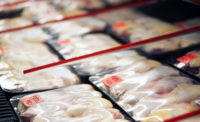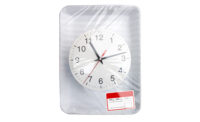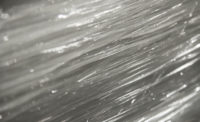Barrier technology is changing, between the lines


|
The two primary players forming the backbone of most packaging formats for refrigerated products, EVOH and Saran, have delivered outstanding high-barrier performance for years. But, both have their well-documented shortcomings, as well.
With regard to EVOH, there has been a technical shift designed to help mitigate its sensitivity to moisture and the degradation of its oxygen barrier characteristics that such exposure causes over time. EVOH is a good actor. It is easy to extrude and forms easily for thermoforming applications and delivers a complete barrier as long as moisture is not part of the equation. However, a new and creative twist is now in the market. Recently, a proprietary EVOH resin with an oxygen scavenging component added into it to act as a supplement during high-moisture conditions is potentially expanding the breadth of applications suited to this workhorse. As the barrier properties degrade with moisture and allow increased oxygen to migrate into the package it is scavenged, therefore, maintaining barrier and the extended freshness of the product.
This is just the latest manifestation of resin-based oxygen scavenging materials that supplement barrier properties. The ultraviolet light-triggered scavenging package has been establishing traction in the marketplace for the past two or three years and has seen some success in processed meat applications.
Saran also remains as an extremely good high-barrier material and still enjoys wide use in a variety packaging formats such as bags, for example, and as a coating for polyester for lidding materials, pouches and film overwraps. In an era of heightened environmental sensitivities, Saran is an unpopular choice in some regions of the world.
As for medium-barrier applications the tried and true Nylon is still the popular choice where long shelf-life or product color degradation are not concerns.Looking at the current big picture of barrier films packaging in the meat industry, it would not be a complete exaggeration just to shrug your shoulders and think not a lot is changing.
The two primary players forming the backbone of most packaging formats for refrigerated products, EVOH and Saran, have delivered outstanding high-barrier performance for years. But, both have their well-documented shortcomings, as well.
With regard to EVOH, there has been a technical shift designed to help mitigate its sensitivity to moisture and the degradation of its oxygen barrier characteristics that such exposure causes over time. EVOH is a good actor. It is easy to extrude and forms easily for thermoforming applications and delivers a complete barrier as long as moisture is not part of the equation. However, a new and creative twist is now in the market. Recently, a proprietary EVOH resin with an oxygen scavenging component added into it to act as a supplement during high-moisture conditions is potentially expanding the breadth of applications suited to this workhorse. As the barrier properties degrade with moisture and allow increased oxygen to migrate into the package it is scavenged, therefore, maintaining barrier and the extended freshness of the product.
This is just the latest manifestation of resin-based oxygen scavenging materials that supplement barrier properties. The ultraviolet light-triggered scavenging package has been establishing traction in the marketplace for the past two or three years and has seen some success in processed meat applications.
Saran also remains as an extremely good high-barrier material and still enjoys wide use in a variety packaging formats such as bags, for example, and as a coating for polyester for lidding materials, pouches and film overwraps. In an era of heightened environmental sensitivities, Saran is an unpopular choice in some regions of the world.
As for medium-barrier applications the tried and true Nylon is still the popular choice where long shelf-life or product color degradation are not concerns.
Looking for a reprint of this article?
From high-res PDFs to custom plaques, order your copy today!









